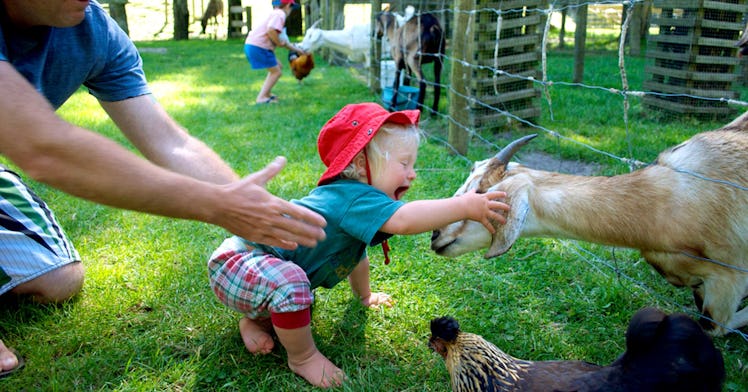Data Shows Petting Zoos Are Crawling With Antibiotic-Resistant Bacteria
Look, a goat! Look, a drug-resistant strain of beta-lactamase bacteria!

Petting zoos aren’t just full of sad-looking animals. According to new research, these common attractions abound with infectious bacteria that could be passed onto animal-loving kids. The findings, presented at this year’s European Congress of Clinical Microbiology & Infectious Diseases in Amsterdam, suggest that, though interacting with animals is healthy for children, the risk of contracting antibiotic-resistant pathogens may make petting zoo visits unworthy of the Instagrams snaps.
“Our findings demonstrate that animals in petting zoos can result in shedding and transmission of MDR pathogens that may cause illness for human visitors, even when the animals appear healthy,” study author Shiri Navon-Venezia, a professor of microbiology at Ariel University in Israel, said in a statement.
Navon-Venezia noted that prior research indicates that petting zoos help children with their social, emotional, and cognitive development before adding that scientists have grown increasingly concerned in recent years that they may also be a breeding ground for dangerous bacteria. Researchers are particularly worried about Extended spectrum beta-lactamase (ESBL) and AmpC-producing Enterobacteriaceae (AmpC-E), which can cause digestive problems, skin infections, pneumonia, urinary tract infections, and even sepsis. These bacteria can be transmitted between people and animals easily and are resistant to a number of commonly used antibiotics.
To get an idea of how prevalent this bacteria is among petting zoo animals, Navon-Venezia and her colleagues obtained 382 skin, fur, feather, and fecal matter samples from 228 animals belonging to 42 different species and 8 different zoos. Some 12 percent of animals were colonized with either ESBL or AmpC-E bacteria, and a quarter of those animals had multiple drug-resistant bacteria strains. These included E. coli ST656, a strain known for causing diarrhea while traveling, and E. coli ST127, a strain known for causing urinary tract infections. Animals that were treated with antibiotics were seven times more likely to pass the multidrug-resistant bacteria onto other animals.
The good news is that 77 percent of the bacteria were found in fecal matter, which may not be the first things kids want to touch at the petting zoo. That doesn’t change that 23 percent of bacteria found on the skin and fur and could be passed onto curious kids. Still, the researchers did not look at whether or not bacteria was being passed onto kids directly. The warnings emerging from the study are based on the prevalence of bacteria alone, which may be enough.
Ultimately, Navon-Venezia is not calling for an end of petting zoos, just massive hygienic overhaul so children can continue to reap the benefits and skirt the risks.
“We recognize the high educational and emotional value of petting zoos for children, therefore, we strongly recommend that petting zoo management teams implement a strict hygiene and infection control policy, together with rationalized antibiotic policy, in order to reduce the risk of transmission between animals and visitors,” Navon-Venezia concluded. “Immediate actions by zoo operators should include installation of handwashing stations to ensure proper handwashing before and after petting animals, prohibiting food and drinking near animals, and also not allowing petting of animals receiving antibiotic treatment.”